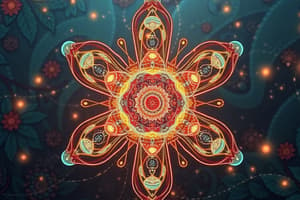Podcast
Questions and Answers
What is the charge of a neutron in an atom?
What is the charge of a neutron in an atom?
- +0.5
- 0 (correct)
- -1
- +1
Where are electrons located within an atom?
Where are electrons located within an atom?
- In the nucleus and in shells
- In shells surrounding the nucleus (correct)
- In the nucleus
- In the energy core
An atom's atomic number is determined by the number of which type of particle?
An atom's atomic number is determined by the number of which type of particle?
- Neutrons
- Protons (correct)
- Nucleons
- Electrons
What is the approximate mass of a proton?
What is the approximate mass of a proton?
In an atom the nucleus is primarily composed of which particles?
In an atom the nucleus is primarily composed of which particles?
How many different types of atom have scientists identified?
How many different types of atom have scientists identified?
What term is used to describe electrons in the outer energy level of an atom?
What term is used to describe electrons in the outer energy level of an atom?
If an atom were scaled to the size of the O2 arena, how big would the nucleus be?
If an atom were scaled to the size of the O2 arena, how big would the nucleus be?
What does the atomic number of an element indicate?
What does the atomic number of an element indicate?
If an atom has a mass number of 31 and an atomic number of 15, how many neutrons does it have?
If an atom has a mass number of 31 and an atomic number of 15, how many neutrons does it have?
What is represented by the symbol 'Li' on the Periodic Table?
What is represented by the symbol 'Li' on the Periodic Table?
Which statement correctly describes mass number?
Which statement correctly describes mass number?
Which element has an atomic number of 8?
Which element has an atomic number of 8?
If a potassium atom has 19 protons, what will be its atomic number?
If a potassium atom has 19 protons, what will be its atomic number?
In a nuclear symbol, what does the lower number represent?
In a nuclear symbol, what does the lower number represent?
Given the nuclear symbol for phosphorus is $ ext{P}^{31}_{15}$, how many total particles are in the nucleus?
Given the nuclear symbol for phosphorus is $ ext{P}^{31}_{15}$, how many total particles are in the nucleus?
Flashcards are hidden until you start studying
Study Notes
Atomic Structure Overview
- All matter consists of particles called atoms.
- Atoms are made of sub-atomic particles: protons, neutrons, and electrons.
Components of an Atom
- Nucleus: Centrally located, positively charged area composed of protons and neutrons.
- Size Comparison: If an atom were the size of an arena, the nucleus would be the size of a table tennis ball.
- Electron Shells: Surround the nucleus, contain electrons arranged in layers or energy levels.
Sub-Atomic Particles
- Protons:
- Charge: +1
- Mass: 1 (found in the nucleus)
- Neutrons:
- Charge: 0
- Mass: 1 (found in the nucleus)
- Electrons:
- Charge: -1
- Mass: Almost 0 (located in shells surrounding the nucleus)
Valence Electrons
- Definition: The electrons in the outermost energy level of an atom.
- Importance: Valence electrons are involved in bonding and chemical reactions.
Atomic Number and Mass Number
- Elements: 118 different types of atoms known, each with a unique number of protons.
- Atomic Number: Indicates the number of protons in an element's nucleus; e.g., Lithium (Li) has an atomic number of 3.
- Mass Number: Total number of protons and neutrons in the nucleus; for Lithium, the mass number is 7.
Nuclear Symbols
- Representation: Utilizes chemical symbol and mass/atomic numbers to convey atomic structure.
- Example: For Phosphorus (P), atomic number 15 and mass number 31 indicate 15 protons and 16 neutrons (31 - 15 = 16).
Practice and Application
- Understanding nuclear symbols allows calculation of protons and neutrons in various elements.
- Example: Oxygen (O) with a nuclear symbol displaying atomic number 8 and a mass number of 16 includes 8 protons and 8 neutrons.
- Potassium (K): Has 19 protons and 20 neutrons, forming its nuclear symbol as 39/19 K.
Studying That Suits You
Use AI to generate personalized quizzes and flashcards to suit your learning preferences.





